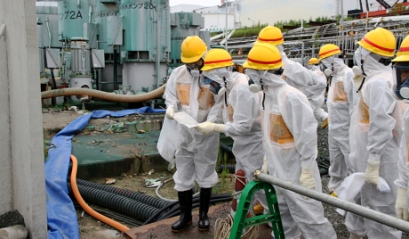日本からの輸入品、放射能汚染を示す
From Sri Lanka
スリランカより
December 25, 2013, 6:15 pm
-pdc--FINA.jpg)
By Ifham Nizam
Sri Lanka is not subject to any direct impact on its marine environment due to radioactive releases from the Fukushima accident, according to a comprehensive study. But radiation levels, particularly in seafood items imported from Japan, had noticeably increased an expert said.
包括的な研究によれば、スリランカは福島事故からの放射能放出による海洋環境に直接的影響は受けていない。しかし特に日本から輸入されている海産物に含まれる放射能レベルは著しく上昇していると専門家は話す。
Atomic Energy Authority (AEA) National Project Coordinator, Director Life Sciences Head Wijeya A. Waduge said yesterday the study had been carried out with technical know-how from the International Atomic Energy Authority (IAEA).
原子力公社の国家プロジェクトのまとめ役である生命科学部長、Waduge氏は昨日、IAEAの技術的なノウハウを使った研究を 実施したと話した。
Following the study, Sri Lanka had successfully established baseline data for marine radioactivity around it, he said, noting that Sri Lanka had not reached the radiation danger zone, but it was time for all relevant stakeholders to be on the alert. Investigations were conducted to ascertain the varying radiation levels that already exist in the country.
その研究の後、スリランカは海洋放射能データのベースラインを築くことに成功し、スリランカが放射能の危険ゾーンには達していないが、関係者全てが警戒状態でいる時期に来ているのだと述べた。スリランカに既存してる様々な放射能レベルを確かめるための調査が行われた。
Waduge said that radiation levels, particularly in seafood items imported from Japan, had noticeably increased. He attributed the high level to the 2011 disaster at the Fukushima Daichi Nuclear Plant.
日本から輸入された海産物は特に放射能レベルが著しく増加していたとWaduge氏は話す。彼はそれが2011年の福島第一原発で起きた事故の由縁だと考えている。
However, he said that radiation levels were below the danger level of 100 Becquerel (BQ), with the readings indicating the level varying between 15 and 20 (BQ).
しかしながら放射能レベルは危険とされる100ベクレルを下回り、15ベクレルから20ベクレルであったと話した。
Some 40 surface sediment samples and fourteen sea water samples and several biota samples were collected from the sea at several locations around Sri Lanka during the period February 2012 to October 2013 for the study.
2012年2月から2013年10月の間に堆積物のサンプルが40件、海水のサンプル14件、海洋生物のサンプルがいくつかスリランカ周辺の海から調査のために収集された。
Waduge said that the absence of cesium-134 in sediments and seawater suggested that there was no direct impact from Fukushima nuclear accident’s radioactive release on the marine sediment and seawater around Sri Lanka.
堆積物と海水からセシウム134が検出されていないことからスリランカの堆積物と海水が福島原発事故からの直接的影響を受けていないことが分かったとWaduge氏は述べた。
Fresh fish samples collected from the local catch were also analysed for possible contamination for the radio nuclides cesium -137 and -134 during the past two-year period. Results showed that none of the samples was contaminated or influenced by the Fukushima nuclear accident, Waduge said. "This is the first such recorded data available for Cesium-137 and Cesium-134 in the sea water and sea sediment in Sri Lanka, the finding of this work will definitely be of immense use in the future," he added.
過去2年間、周辺の海からとれた新鮮な魚のサンプルも放射性セシウム137と‘134の汚染を確認するために分析された。結果は、どのサンプルも汚染しておらず福島原発事故の影響を受けていないことを示していたと言う。「これは、スリランカで始めて可能となった海水、海中堆積物のセシウム137と134のデータです。この研究からの発見は確実に将来計り知れないほど役にたつでしょう。」と言い添えた。
------------------------------------------------
台湾行政院によると、2012年に台湾へ輸出された日本製品の多くから放射性物質を検出していたとのこと。
お茶、小麦粉、魚など。。。
FDA Taiwan detected high level of radiation in imported foods from Japan in 2012. Green tea, flour, fish etc...
セシウム1キロあたり321ベクレルの粉末緑茶は、台湾標準値370ベクレルを下回っているため市場に出すのに合格しているようです。
It shows green tea powder with Cs 321bq/kg is successful for the distribution to the market because it's less than Taiwanese Standard of 370 bq/kg.

















-pdc--FINA.jpg)






